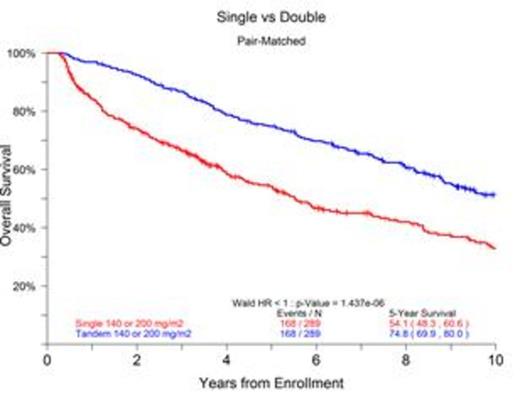Abstract
Introduction
The introduction of melphalan-based high-dose chemotherapy and autologous stem cell transplantation (MEL-ASCT) has markedly improved the survival of patients with multiple myeloma (MM). The initial clinical studies suggested conditioning with melphalan (MEL) 200 mg/m2 was optimum compared to MEL 140mg/m2 or MEL/TBI. Following on from the introduction of a single MEL-ASCT, the use of tandem transplantation was explored and highlighted the potential of this approach to improve outcome. With the introduction of consolidation and maintenance approaches, questions still remain regarding which patients are most appropriate for the tandem approach and what dose of melphalan should be delivered. The Total Therapy (TT) trials were initiated more than 25 years ago and have used tandem MEL-ASCT since their inception. Not all patients treated in our facility received a 2nd MEL-ASCT due to a number of reasons including adverse events during 1st MEL-ASCT or a lack of funding for 2nd ASCT thus limiting access to a tandem treatment approach. A dose-reduced MEL (140 mg/m2) was given to patients with renal impairment or advanced age at 1st and / or 2nd ASCT. Consolidation/Maintenance chemotherapy was introduced from TT2 onwards. This large data set therefore allows us to perform a retrospective pair-matched analysis to address a number of important clinical questions including the role of single versus tandem MEL-ASCT and standard versus dose-reduced tandem MEL-ASCT in the era of novel agents for induction and consolidation/maintenance therapy.
Materials and Methods
We have analyzed data from 1918 patients who were enrolled in Total Therapy 1 - 6 trials. Given the changing chemotherapy regimens within TT trials due to the introduction of novel agents coupled with diverse baseline characteristics, we designed a retrospective pair-matched analysis framework in order to account for differences in patient and treatment variables. This was achieved by generating identical treatment and control group subsets from within the full data set that are identical across key covariates including baseline characteristics of ISS stage, age, and creatinine; protocol anti-myeloma treatment regimens such as dexamethasone, thalidomide, bortezomib, and lenalidomide; and variations in transplantation such as melphalan dosage. The majority of the patients in the TT trials completed induction chemotherapy and received the 1st MEL-ASCT (TT1: 88.3%, TT2: 86.0%, TT3: 97.6%, TT4: 95.0%, TT5: 100% and TT6: 95.1%). Fewer patients received the 2nd MEL-ASCT (TT1: 66.7%, TT2: 68.2%, TT3: 85.0%, TT4: 70.0%, TT5: 74.0%, and TT6: 52.4%). MEL 200 mg/m2 was the predominant dose, administered with MEL 140 mg/m2 given to a smaller fraction of patients due to age and renal impairment restrictions. TT3 has the highest percentage of patients receiving a 2nd MEL-ASCT at 85.0% and most of those at standard dose (MEL 200 mg/m2).
Results
After balancing treatment and control groups with identical treatment, baseline characteristics, and dose of 1st ASCT (140 or 200 mg/m2), we found 289 tandem and 289 single transplant pairs with no significant differences across any of our balancing covariates (all paired Wilcoxon rank test p-values = 1.00). Analysis of these pair-matched cases strongly supported tandem transplantation as superior in outcome-cases with tandem transplantation had 5-year OS rate of 74.8% compared to 54.1% in single transplant cases (logrank p-value: 1.44e-06). For cases with tandem transplantation, we pair-matched 164 cases with tandem 200 mg/m2 transplants to 164 cases with either 140 mg/m2 received as 1st ASCT, 2nd ASCT, or both transplants. Analysis of these pair-matched cases strongly supported tandem 200 mg/m2 over 140 mg/m2 as the 5-year OS rates were 78.5% and 63.6%, respectively (logrank p-value: 1.23e-03).
Conclusion
MEL-ASCT is the backbone for treatment of MM. From our study, there is overwhelming evidence that application of tandem MEL-ASCT delivers superior clinical outcome compared to single MEL-ASCT. In order to achieve the best clinical results tandem MEL-ASCT should be performed using standard dose MEL 200 mg/m2; dose reduction (140 mg/m2) leads to unfavorable clinical outcome. Ongoing analysis aims to reveal the benefits of MEL-ASCT treatment across specific subgroups to better understand differential response and optimal therapy for patients across distinct molecular and risk subgroups.
Thanendrarajan:University of Arkansas for Medical Sciences: Employment. Stein:University of Arkansas for Medical Sciences: Employment. Davies:Celgene: Consultancy; Janssen: Consultancy; Millenium: Consultancy; Onyx: Consultancy; University of Arkansas for Medical Sciences: Employment. van Rhee:University of Arkansa for Medical Sciences: Employment. Zangari:Onyx: Research Funding; University of Arkansas for Medical Sciences: Employment; Millennium: Research Funding; Novartis: Research Funding. Heuck:Millenium: Other: Advisory Board; Janssen: Other: Advisory Board; Celgene: Consultancy; Foundation Medicine: Honoraria; University of Arkansas for Medical Sciences: Employment. Schinke:University of Arkansas for Medical Sciences: Employment. Waheed:University of Arkansas for Medical Sciences: Employment. Jethava:University of Arkansas for Medical Sciences: Employment. Weinhold:University of Arkansas for Medical Sciences: Employment; Janssen Cilag: Other: Advisory Board. Matin:University of Arkansas for Medical Sciences: Employment. Mathur:University of Arkansas for Medical Sciences: Employment. Mohan:University of Arkansas for Medical Sciences: Employment. Radhakrishnan:University of Arkansas for Medical Sciences: Employment. Barlogie:University of Arkansas for Medical Sciences: Employment. Morgan:Celgene: Honoraria, Membership on an entity's Board of Directors or advisory committees; University of Arkansas for Medical Sciences: Employment; Bristol Myers Squibb: Honoraria, Membership on an entity's Board of Directors or advisory committees; CancerNet: Honoraria; MMRF: Honoraria; Takeda: Honoraria, Membership on an entity's Board of Directors or advisory committees; Weismann Institute: Honoraria.
Author notes
Asterisk with author names denotes non-ASH members.



